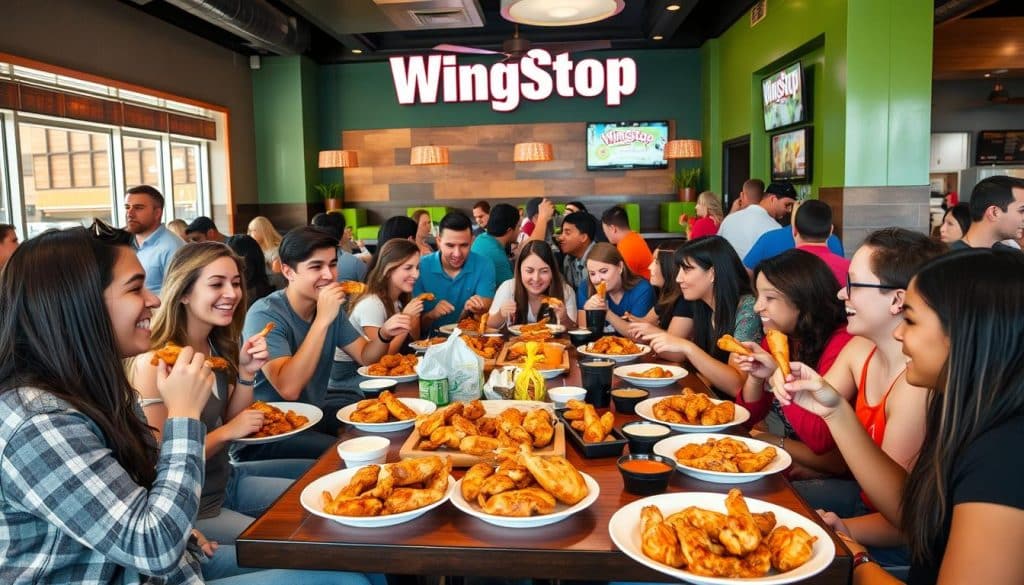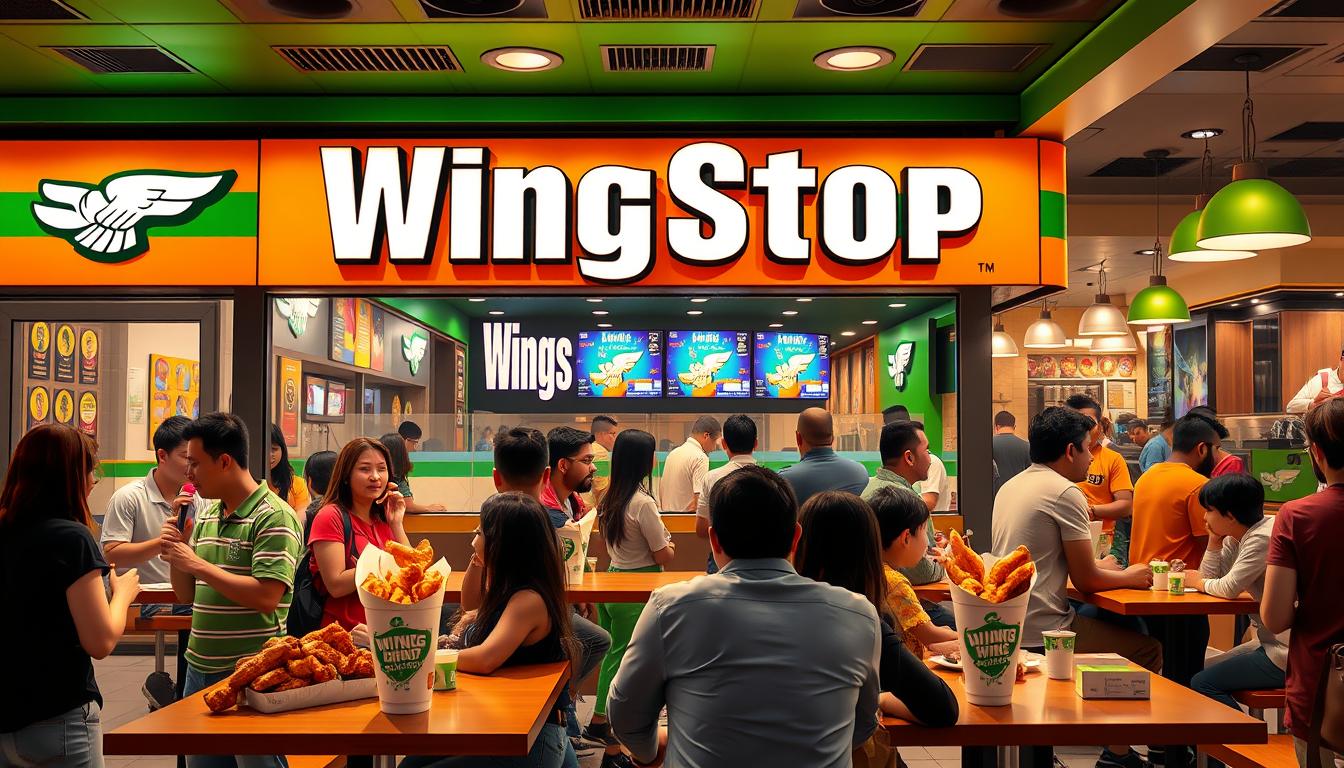Ever thought about starting a franchise in the fast-casual dining world? Wingstop is more than just tasty chicken wings. It’s a successful business model that has grown fast, starting in 1994. Antonio Swad founded it in Garland, Texas, and now it has over 1,500 locations worldwide.
It attracts a wide range of customers, from sports fans to families. We’ll explore key aspects of the Wingstop franchise. This includes the investment needed, its unique structure, benefits, and challenges. If you’re interested in food, community, or making money, learning about Wingstop could be your first step to success.
Key Takeaways
- The initial investment for opening a Wingstop franchise ranges from $315,000 to $975,000.
- Franchisees need a minimum net worth of $1.2 million and at least $600,000 in liquid assets.
- Wingstop charges an initial franchise fee of $20,000 and ongoing royalty fees of 6% of gross sales.
- Franchise owners are required to commit to opening at least three units.
- The brand boasts an impressive 95% renewal rate among franchisees.
- Wingstop’s 3-year growth rate is 43%, significantly surpassing the industry average.
Overview of the Wingstop Franchise Model
Wingstop is a big name in fast-casual dining, thanks to its unique franchise model. It focuses on chicken wings, making its menu stand out. Customers love the variety, from classic buffalo to Mango Habanero, making every visit special.
With over 1,500 locations worldwide, Wingstop’s popularity is clear. It meets different tastes, showing its wide appeal.
Franchisees get a solid business setup to help them succeed. Wingstop offers training and support to keep quality high. This ensures every franchisee can offer the great service Wingstop is known for.
Partnerships are key, helping franchisees grow. Working with delivery services and digital marketing boosts visibility and sales. This helps franchisees thrive in their markets.
The wingstop model is all about efficiency. It lets franchise owners focus on what they do best: serving delicious food. With a focus on quality, Wingstop’s franchisees are set for success in the competitive dining world.
Initial Investment Requirements for Wingstop
Starting a Wingstop franchise requires a big financial investment. It’s key for anyone wanting to join this growing brand to know the wingstop franchise costs.
Costs Breakdown: Franchise Fee and Equipment
The cost to start a Wingstop restaurant varies from $259,000 to $912,000. This includes a $20,000 franchise fee and a $10,000 development fee. Architectural and engineering fees can be from $7,300 to $30,000.
Leasehold improvements can cost between $100,000 to $510,000, depending on the location. Furniture, fixtures, and audio/visual systems add $50,400 to $153,800 to the total cost.
Ongoing Royalties and Advertising Fees
After opening, franchise owners face ongoing fees. A 6% royalty on gross sales, known as wingstop franchise royalties, is needed for brand upkeep and support. Franchisees also pay 4% of gross sales for national marketing.
These ongoing fees for wingstop franchise operations are vital for success and the business’s long-term health.
Benefits of Owning a Wingstop Franchise
Owning a Wingstop franchise comes with many perks. The biggest advantage is the brand’s strong recognition. This attracts a lot of customers, helping you make money faster. Wingstop’s fans expect top-notch food, which boosts your chances of success.
Thanks to national marketing, your franchise gets more visibility. This means more people will know about your business. It’s a big win for those who choose to invest in Wingstop.
Established Brand Recognition
Wingstop’s brand is a game-changer. It sets you apart in the fast-food world. The brand’s success rate is high, showing that owners are happy.
Wingstop has grown by 43% in three years, beating the industry average. This shows it’s a profitable and stable choice. With only a 1% failure rate, you can trust your investment.
Comprehensive Training and Support
Wingstop offers top-notch training and support. You’ll learn about everything from running the business to serving customers. This ensures you’re ready to succeed.
New owners get in-depth training. They also get help with finding the right location and marketing locally. This support helps you manage your restaurant well.
Target Market and Customer Demographics
Knowing who loves Wingstop is key for franchise owners. Wingstop draws in young adults and adults up to 45 who love casual dining. It’s a hit with families and sports fans, perfect for social events.
The brand’s customers mostly have a middle income. This shows Wingstop’s food is affordable and appealing.
Understanding Your Ideal Customer
Wingstop’s customers love flavors like buffalo, lemon pepper, and garlic parmesan. They also enjoy customizing their spice and choosing dipping sauces. This shows a loyal fan base that values quick service and easy ordering.
Wingstop is found in cities and suburbs, making it easy to get to. This adds to its appeal for many.

Trends in the Fast-Casual Dining Sector
The fast-casual dining world is always changing, and Wingstop keeps up. People want high-quality, quick meals more than ever. Wingstop meets this need with takeout and delivery, perfect for those on the go.
With digital sales making up over 60% of revenue, Wingstop is ready for new trends. It keeps its brand strong while meeting customer needs.
Location Selection for Wingstop Franchise
Choosing the right spot is key for a Wingstop franchise to thrive. You need to think about visibility, foot traffic, competition, and rent. Pick places with lots of people, like shopping centers or near sports venues. This can boost sales and attract more customers.
Key Considerations for Site Selection
When picking a spot for your Wingstop, look at foot traffic, nearby businesses, and competition. These factors help keep customers coming back. Doing your homework is essential for a successful start and growth.
Demographic Analysis for Optimal Performance
Understanding who your customers are is vital for Wingstop. Know the local demographics, like age, income, and interests. This helps tailor your marketing and menu to fit the community. It makes your Wingstop more appealing to locals.
Marketing Strategies for Wingstop Franchisees
Marketing is key for Wingstop franchisees to grab attention and boost sales. Digital marketing is now more important than ever. Using social media to share special deals and new menu items helps build a community around the brand.
A good online marketing plan can make a big splash. It turns interest into real visits to the restaurant.
Utilizing Digital Marketing and Social Media
Franchisees can use digital marketing to reach more people. Platforms like Instagram, Facebook, and Twitter are great for this. They help increase customer interaction and make the brand more visible.
Creative content, like videos of tasty wings or kitchen tours, draws in more viewers. This meets the growing need for quick and easy service. By focusing on technology, Wingstop can meet and exceed customer expectations.
Local Marketing Tactics that Work
Local marketing is essential for Wingstop to attract more customers and build loyalty. Franchisees can run promotions and sponsor local events to connect with the community. This not only boosts brand awareness but also strengthens ties with local customers.
By using these marketing strategies, franchisees can achieve long-term success and profitability.
Success Stories from Wingstop Franchise Owners
Many Wingstop franchise owners have shared their amazing stories. They show how the brand can thrive in the fast-casual dining world. Their success stories highlight the importance of innovation and hard work.
Understanding what local customers want and adapting to their needs is key. Franchisees who connect with their communities often do better.
High-Performing Locations and Their Strategies
Top Wingstop franchises have strategies that others can follow. They make their menus fit local tastes and use creative marketing. Teamwork and a love for the brand are also important for success.
These locations have seen their sales go up. They use technology to make things run smoother and improve customer service.
Testimonials and Insights from Owners
Wingstop franchise owners share their experiences. They talk about the support they get from the brand. This support helps them face the challenges of running a franchise.
They find joy in building a business that reflects their passions. Their stories show a strong system that supports growth and keeps the franchise going. This encourages others to look into Wingstop as an investment.
Challenges Faced by Wingstop Franchisees
Owning a Wingstop franchise comes with its own set of challenges. High initial investments and ongoing costs are common hurdles. Owners also face issues like choosing the wrong location and not keeping up with market changes. To overcome these, it’s important to do thorough research and use Wingstop’s support.
Common Pitfalls and How to Avoid Them
One major mistake is ignoring local demographics and what customers want. Knowing these details helps in making smart choices about menus and promotions. Engaging with the community and watching for changes in what people like are key. This way, owners can meet customer needs and avoid problems.
Navigating Competition in the Market
The market for Wingstop is very competitive, with many places serving similar food. To stand out, owners need strong marketing plans. Creating a welcoming space and unique promotions can draw in new customers. Keeping up with the latest in fast-casual dining is also important to stay ahead.

Future Growth and Expansion of Wingstop
Wingstop is leading the quick-service restaurant sector with a focus on franchise growth. System-wide sales jumped 36.8% to $1.1 billion, with digital sales making up 68.3%. This shows the brand’s ability to keep up with market trends, attracting new franchise owners. The first quarter of 2024 saw 65 new locations open, showing Wingstop’s growth plans are on track.
New Market Trends and Opportunities
Digital sales are up, showing people want online ordering and delivery. Wingstop’s same-store sales rose 21.6% domestically. This shows the brand is strong and can draw in customers, even as dining habits change. Franchisees can use these trends to grow and find new opportunities.
Wingstop’s Vision for the Coming Years
Wingstop’s leaders have a clear vision for the future. They aim to grow in both domestic and international markets. They expect to open 275 to 295 new units and see same-store sales increase by low double digits.
The brand is focusing on technology and new marketing to stay ahead. With strong revenue growth, Wingstop is ready for more success and expansion.
FAQ
What are the initial franchise requirements for Wingstop?
FAQ
What are the initial franchise requirements for Wingstop?
To start a Wingstop franchise, you need at least
FAQ
What are the initial franchise requirements for Wingstop?
To start a Wingstop franchise, you need at least $1 million in net worth. You also need $300,000 in liquid assets. Plus, having business experience is a must.
How much does it cost to open a Wingstop franchise?
Opening a Wingstop franchise costs between $259,400 and $912,100. This includes a $20,000 franchise fee and $10,000 development fee. You’ll also need to invest in leasehold improvements and equipment.
What ongoing fees are associated with owning a Wingstop franchise?
You’ll pay a 6% royalty fee on gross sales. You’ll also give 4% of gross sales for national marketing.
What training and support does Wingstop offer to franchisees?
Wingstop offers detailed training in operations, marketing, and customer service. New owners get initial training and ongoing support. This includes help with site selection and local marketing.
What marketing strategies can Wingstop franchisees use to attract customers?
Use digital marketing and social media to connect with customers. Local marketing like community events and sponsorships can also help.
What targeting strategies should Wingstop franchisees consider for their market?
Know your customers, like young adults and families. Use demographic analysis to tailor your marketing and menu.
How can I ensure the success of my Wingstop franchise?
Do thorough market research and pick busy locations. Stay up-to-date with trends and engage with your community.
What are the common challenges faced by Wingstop franchise owners?
Challenges include high costs and ongoing expenses. Choosing the wrong location and competing with others are also hurdles.
What is the success rate for Wingstop franchises?
Wingstop has a 95% success rate in renewals. This shows its business model is sustainable and profitable.
How does Wingstop plan to expand in the future?
Wingstop will focus on new markets and trends like online ordering. This will help it stay competitive.
million in net worth. You also need 0,000 in liquid assets. Plus, having business experience is a must.
How much does it cost to open a Wingstop franchise?
Opening a Wingstop franchise costs between 9,400 and 2,100. This includes a ,000 franchise fee and ,000 development fee. You’ll also need to invest in leasehold improvements and equipment.
What ongoing fees are associated with owning a Wingstop franchise?
You’ll pay a 6% royalty fee on gross sales. You’ll also give 4% of gross sales for national marketing.
What training and support does Wingstop offer to franchisees?
Wingstop offers detailed training in operations, marketing, and customer service. New owners get initial training and ongoing support. This includes help with site selection and local marketing.
What marketing strategies can Wingstop franchisees use to attract customers?
Use digital marketing and social media to connect with customers. Local marketing like community events and sponsorships can also help.
What targeting strategies should Wingstop franchisees consider for their market?
Know your customers, like young adults and families. Use demographic analysis to tailor your marketing and menu.
How can I ensure the success of my Wingstop franchise?
Do thorough market research and pick busy locations. Stay up-to-date with trends and engage with your community.
What are the common challenges faced by Wingstop franchise owners?
Challenges include high costs and ongoing expenses. Choosing the wrong location and competing with others are also hurdles.
What is the success rate for Wingstop franchises?
Wingstop has a 95% success rate in renewals. This shows its business model is sustainable and profitable.
How does Wingstop plan to expand in the future?
Wingstop will focus on new markets and trends like online ordering. This will help it stay competitive.





